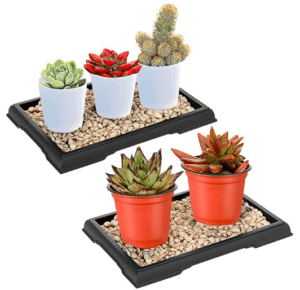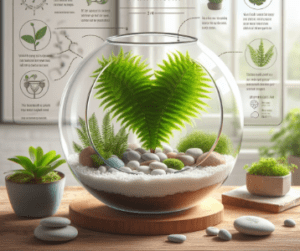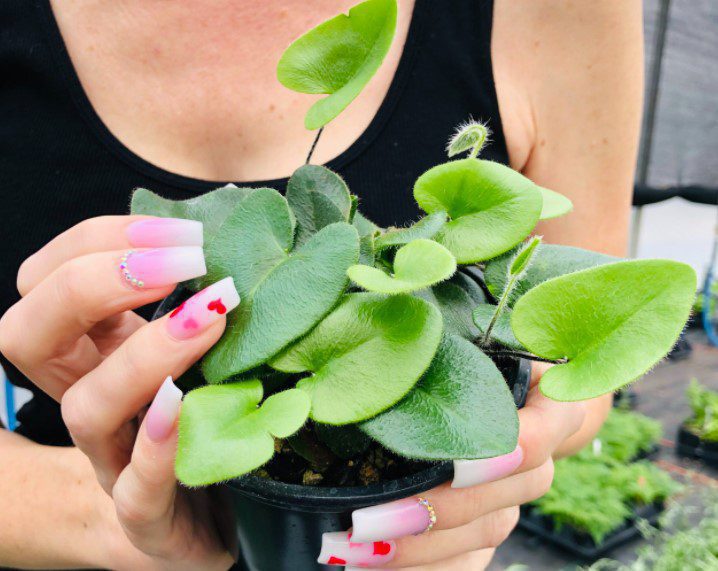The sweet heart fern (Hemionitis arifolia) is a dainty dwarf fern with bright green, heart-shaped leaves on dark stems. Native to Southeast Asia, this delicate fern adds a touch of whimsy to your indoor spaces.
Common Challenges with Heart Ferns
Heart ferns crave high humidity and struggle in average home environments. Look out for these signs of trouble:
- Brown, crispy leaf edges (usually means low humidity)
- Yellowing leaves (could be overwatering or lack of humidity)
- Slow or stunted growth (several causes, but humidity is often a factor)
Solutions:

- Humidifier: The best way to boost moisture around your fern.
Click here to buy it on Amazon

- Pebble Tray: Place the pot on a tray of pebbles and water (water shouldn’t touch the pot).
Click here to buy it on Amazon
- Misting: Regular misting helps, but it’s a temporary fix.
Note: Consistent humidity is key!
Heart Fern Care

The Basics
This fern needs warmth and moisture to thrive. While traditionally used in terrariums or greenhouses, it can be a rewarding houseplant with the right care.
- Temperature: 60-85 degrees F (13-29 C), with cooler nights.
- Light: Bright, indirect sunlight. Avoid direct sun.
- Water: Keep the soil consistently moist, but not soggy. Allow the top inch to dry out slightly between waterings. Use soft or distilled water if possible.
- Soil: Well-draining mix with humus (a mix of sand, garden soil, humus, and aquarium charcoal works well). Choose a pot with good drainage, terracotta can be helpful.
- Fertilizer: Diluted, water-soluble fertilizer once per month.
- Pests: Susceptible to scale, mealybugs, and aphids. Remove by hand or use neem oil.
- Repotting: Repot your heart fern when roots start to poke out of the drainage holes, usually in spring.
Quick Care Recap
| Care Factor | Description |
|---|---|
| Light | Bright, indirect sunlight |
| Water | Keep soil moist, not soggy |
| Humidity | High humidity is essential |
| Temperature | 60-85°F (13-29°C), cooler at night |
| Fertilizer | Diluted, once a month |
Interesting Facts
- Traditional Medicine: Heart ferns were used in Southeast Asian cultures to treat diabetes. (Reminder: Consult a doctor for modern treatment)
- Unique Spores: Unlike most ferns, the heart fern’s reproductive spores are located on the top surface of its leaves.
FAQs
- Why are my heart fern’s leaves turning brown? The most common culprit is low humidity.
- Can my heart fern live outside? Only if you live in a consistently warm, humid climate similar to its native environment
- How often should I water my heart fern? There’s no set schedule, check the soil by touch. Water when the top inch feels dry.
-
Is the heart leaf fern rare? Heart leaf ferns aren’t considered extremely rare, but they’re less common than many other house ferns. You can often find them at specialty plant nurseries, garden centers, or reputable online plant shops.
-
How do you propagate a heart fern? Heart ferns are propagated from spores rather than cuttings like many ferns. Here’s the basic process:
-
Collect spores: Look for mature leaves with brown, powdery patches on the top surface.
-
Sow spores: Spread the spores on a moist seed-starting mix or peat moss.
-
Create a humid environment: Cover the spores with a lid or plastic wrap and place them in a bright but indirectly lit location.
-
Keep moist: Mist the growing medium regularly to maintain moisture.
-
Be patient: Spore germination can take several months.
- Why is my heart fern turning yellow? Yellowing leaves are often a sign of overwatering. Check the soil – if it’s soggy, let it dry out more between waterings. Less commonly, low humidity or nutrient deficiencies can also cause yellowing.
- Is heart fern toxic to cats and dogs? Good news! Heart ferns are considered non-toxic to cats and dogs. However, it’s always best to supervise pets around houseplants to deter them from nibbling.
- Is my heart fern difficult to grow? Heart ferns have a reputation for being a bit finicky, but it’s more about understanding their specific requirements. They thrive in high humidity, warm temperatures, and indirect light. With the right care, they can be rewarding houseplants.
- Where can I buy a heart fern? Here are a few good places to look for heart ferns:
- Local Nurseries & Garden Centers: Especially those specializing in houseplants or ferns.
- Online Plant Retailers: Websites like Etsy often have sellers offering heart ferns.
- Plant Enthusiast Communities: Check social media groups or local plant swaps.
Heart ferns bring a touch of the exotic to your home. With a little extra attention, you’ll be rewarded with lush, unique foliage.























